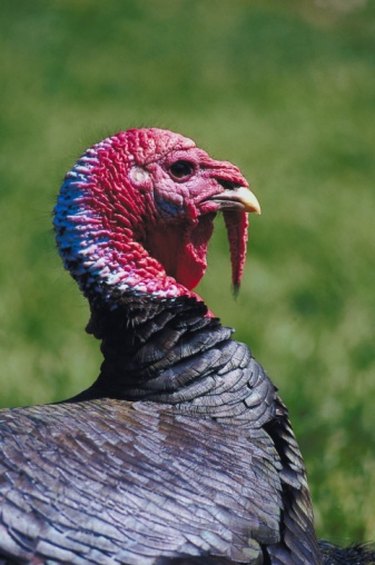
If you want to attract birds to your yard, plant a hawthorn tree. The more than 1,000 species of hawthorns (Crataegus) provide nourishment for a variety of wildlife. The trees produce yellow, orange or red fruit, also called haws or thorn-apples, in the fall and winter. These brightly colored fruits attract many species of birds, including ground dwellers and song birds. The birds feed on the berries then disperse the seeds through their digestive process, which helps to regenerate the hawthorn plants.
Wild Turkey
Video of the Day
The wild turkey (Meleagris gallopavo) is native to North America. This large, ground-dwelling bird ranges from the Eastern U.S. to the Midwest, down to Southern Mexico and in some locations on the West Coast of the U.S. Turkeys forage for food along the ground and eat berries, seeds, nuts and even the occasional small animal, such as salamanders. Males can grow up to 24 pounds and have prominent, fan-shaped tail feathers.
Video of the Day
Black-capped Chickadee
The black-capped chickadee (Parus atricapillus) is native to North America and ranges throughout Canada and most of the upper U.S. These small birds prefer to live in wooded areas populated by deciduous trees. Black-capped chickadees eat both plant and animal foods, such as berries, seeds, insects and spiders. On average, birds weigh about 0.37 oz. and have black heads and chests and white cheeks.
Cedar Waxwing
The cedar waxwing (Bombycilla cedrorum) is a North American native. In warmer months, the birds range from Southern Canada to the Northern U.S. and in winter months, across the U.S., Mexico and Central America, sometimes as far south as Panama and the Caribbean. Cedar waxwings prefer open woodlands and riparian habitats. This species' average size is 6 inches and 1.13 oz. Both sexes display a black mask, yellow chests and wing feathers tipped with red. Cedar waxwings eat fruit and berries in the winter and insects in the summer.
Northern Mockingbird
Northern mockingbirds (Mimus polyglottos) are grayish-brown songbirds with white-striped wings. These birds love to sing, even in the dark. Mockingbirds range across the U.S., Mexico and the Caribbean. The birds prefer to live in open areas with hedges, shrubs and grassy areas, such as parks, backyards and suburban areas. The northern mockingbird eats berries through the summer and insects, worms and even lizards in the winter. The average northern mockingbird is between 8 and 10 inches long and weighs up to 2 oz.
- Cornell Lab of Ornithology: All About Birds: Wild Turkey
- University of Michigan Museum of Zoology: Animal Diversity Web: Parus Atricapillus Black-capped Chickadee
- University of Michigan Museum of Zoology: Animal Diversity Web: Bombycilla Cedrorum Cedar Waxwing
- Cornell Lab of Ornithology: All About Birds: Northern Mockingbird
- Royal Society for the Protection of Birds: Birds and Berries
- Prairie Fire: Planting (is) for the Birds